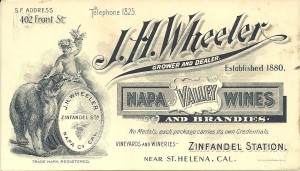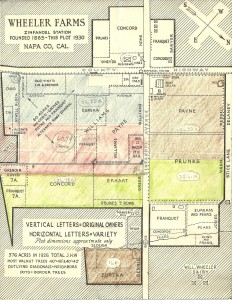[et_pb_section fb_built=”1″ _builder_version=”3.22″][et_pb_row _builder_version=”3.25″ background_size=”initial” background_position=”top_left” background_repeat=”repeat”][et_pb_column type=”4_4″ _builder_version=”3.25″ custom_padding=”|||” custom_padding__hover=”|||”][et_pb_text admin_label=”Text” _builder_version=”4.4.8″ background_size=”initial” background_position=”top_left” background_repeat=”repeat” hover_enabled=”0″ use_border_color=”off” border_color=”#ffffff” border_style=”solid”]
Wheeler Farms in St. Helena
 Americans sought to establish a domestic wine industry as far back as Britain’s settlement at Jamestown, Virginia. The Jamestown colony didn’t succeed at it because settlers tried to do it with European grapevines of a species that could not survive for long in America. Still, throughout the American colonies and after the American Revolution luminaries like Thomas Jefferson and his friend Dr. Benjamin Rush kept the dream alive. The dream became reality in the early 19th century with the discovery of hybrid grapes with names like Catawba and Isabella, which were field crosses between transplanted European and Native American vines.
Americans sought to establish a domestic wine industry as far back as Britain’s settlement at Jamestown, Virginia. The Jamestown colony didn’t succeed at it because settlers tried to do it with European grapevines of a species that could not survive for long in America. Still, throughout the American colonies and after the American Revolution luminaries like Thomas Jefferson and his friend Dr. Benjamin Rush kept the dream alive. The dream became reality in the early 19th century with the discovery of hybrid grapes with names like Catawba and Isabella, which were field crosses between transplanted European and Native American vines.
Catawba vineyards came to the 5,000 square mile Finger Lakes region of New York with the arrival in 1829 of Reverend William Bostwick in Hammondsport, at the southern end of the unusually y-shaped Keuka Lake, in the heart of the region. The good reverend planted grapes both for eating and for sacramental wine. By 1836, Samuel Warren established the first Finger Lakes commercial winery located about 80 miles northwest of Hammondsport in the town of York, at the western edge of the region. The winery lasted a few decades but was done in by the eminent domain of the railroad.
Meanwhile, from Bostwick’s plantings, Keuka Lakers developed a successful table grape industry. Then in 1858, Charles Wheeler of Hammondsport established the first Keuka winery, followed by the Pleasant Valley Wine Company in 1860. Between 1860 and 1880, dozens of wineries came and went around Keuka and by 1880, when the Taylor family established what would become the wildly successful Taylor Wine Company, the lake had become the center of the New York State wine industry, holding that position for more than 100 years, with Catawba among the most successful grape varieties.[1]
Born in Vergennes, Vermont, Charles Wheeler had built up a successful grain and milling business in Oswego, New York. In 1867 Charles moved his two sons, John H. Wheeler and Rollo C. Wheeler, to Vallejo, California and entered the grain business there. In 1869, he purchased property two miles south of St. Helena at Pine Station, later known as Bell Station and today known as Zinfandel Lane. The original vineyard of Charles Wheeler was about one mile north of Ink and southwest of the junction of the highway and Zinfandel Lane, and conveniently near Bell Station. He bought this Napa property from James M. Thompson (a son of Simpson Thompson, owner of the Suscol Ranch dating from the 1850s). At this location was built a stone winery on the family farm known as Wheeler Farms, constructed by W. P. Weeks and J. Weinberger.
 Wheeler increased the vineyard to some eighty acres and established a home. He built a stone winery in the mid-1880s and his two sons, Rollo and John H., as they grew learned both viticulture and winemaking. Before his death, Wheeler Sr. turned over the business to Rollo, who remained in charge until his own tragic death in 1889 from a horse’s kick. John was the younger brother and a graduate of the University of California, class of 1879.
Wheeler increased the vineyard to some eighty acres and established a home. He built a stone winery in the mid-1880s and his two sons, Rollo and John H., as they grew learned both viticulture and winemaking. Before his death, Wheeler Sr. turned over the business to Rollo, who remained in charge until his own tragic death in 1889 from a horse’s kick. John was the younger brother and a graduate of the University of California, class of 1879.
Under the influence of fellow ‘Cal Boy’ Charles Wetmore Wheeler purchased land in the Livermore Valley in the mid-1880s and there planted a vineyard that he named the Cornelia, after his eldest daughter, but he continued to live at Bell Station. In 1891 he was credited with making a half million gallons of wine, but as the capacity of the Bell Station winery was only 300,000 gallons, this total must have included wine made at Calistoga, (where he also had a vineyard and a winery), and possibly some wine made from grapes grown in his Livermore vineyard.
About 1894 Wheeler greatly increased his holdings by purchasing a one-hundred-acre parcel that lay north and east of the highway and Zinfandel Lane. The land had been settled in 1852 by Matthew Vann, who had crossed the plains from Illinois in 1850. Along with general farming, Vann began planting wine grapes about 1865; in the early 1880s he had sixty-four acres in grapes and built a winery. He maintained the winery in partnership with his sons until selling out to Wheeler.
 According to accounts recorded by Thomas Pinney, A History of Wine in America (2005), “another longtime Napa winegrower, one with connections going back to the early days of the industry there, was John H. Wheeler. Wheeler whose winery was at Zinfandel Lane, south of St. Helena, had been replanting his vineyards to walnuts and other crops in anticipation of the coming Prohibition, but still had some 60 acres of vines in 1924. Wheeler made wine at Bell Station until Prohibition, and he had a distillery that produced from six to ten thousand gallons of brandy annually. He made only a little wine during the Prohibition, but he could not manage to get rid of even that little and had to ask the authorities for permission to dump it. In 1930, the operation was wound up, and although Wheeler reopened his winery on repeal, he was then an old man, able to continue for only a few years.”[2] Part of the old winery building was incorporated into the house now occupying the site.[3]
According to accounts recorded by Thomas Pinney, A History of Wine in America (2005), “another longtime Napa winegrower, one with connections going back to the early days of the industry there, was John H. Wheeler. Wheeler whose winery was at Zinfandel Lane, south of St. Helena, had been replanting his vineyards to walnuts and other crops in anticipation of the coming Prohibition, but still had some 60 acres of vines in 1924. Wheeler made wine at Bell Station until Prohibition, and he had a distillery that produced from six to ten thousand gallons of brandy annually. He made only a little wine during the Prohibition, but he could not manage to get rid of even that little and had to ask the authorities for permission to dump it. In 1930, the operation was wound up, and although Wheeler reopened his winery on repeal, he was then an old man, able to continue for only a few years.”[2] Part of the old winery building was incorporated into the house now occupying the site.[3]
The winery has since been torn down but the original craftsman style home still stands on the west side of highway 129 just south of the railroad tracks at Zinfandel Lane.[4]
Although Wheeler was a successful vineyardist and winemaker, it was rather through his chemical factory at Melrose in Alameda County that he became wealthy. He began by producing bisulphide and eventually led to the founding and growth of Stauffer Chemical Company.
[1] http://www.fingerlakes.com/wine downloaded from internet on April 27, 2015
2 Thomas Pinney (2005). A History of Wine in America: From Prohibition to the Present, Volume 2.
University of California Press, Jun 5, 2005
[3] Peninou, Ernest P. (1965). A History of the Napa Viticulture District comprising the counties of Napa, Solano, and Contra Costa – with grape acreage statistics and directories of grape growers. An Unpublished Manuscript, 1965, 1993, 1995, 2000 pgs.50-52
[4] Image 97. From Valerie Goods collection of photos.
[/et_pb_text][/et_pb_column][/et_pb_row][/et_pb_section][et_pb_section fb_built=”1″ _builder_version=”3.22″][et_pb_row _builder_version=”3.25″ background_size=”initial” background_position=”top_left” background_repeat=”repeat”][et_pb_column type=”4_4″ _builder_version=”3.25″ custom_padding=”|||” custom_padding__hover=”|||”][et_pb_divider color=”#cccccc” disabled_on=”on|on|off” admin_label=”Divider” _builder_version=”3.23.4″ height=”3px” hide_on_mobile=”on”][/et_pb_divider][/et_pb_column][/et_pb_row][et_pb_row _builder_version=”3.25″ background_size=”initial” background_position=”top_left” background_repeat=”repeat”][et_pb_column type=”4_4″ _builder_version=”3.25″ custom_padding=”|||” custom_padding__hover=”|||”][et_pb_text admin_label=”Text” _builder_version=”3.27.4″ background_size=”initial” background_position=”top_left” background_repeat=”repeat” use_border_color=”off” border_color=”#ffffff” border_style=”solid”]
Items related to Wheeler Farms
[/et_pb_text][et_pb_blog fullwidth=”off” include_categories=”3″ show_more=”on” show_author=”off” show_date=”off” admin_label=”Blog” _builder_version=”3.0.94″ use_border_color=”off” border_color=”#ffffff” border_style=”solid” use_dropshadow=”off”][/et_pb_blog][/et_pb_column][/et_pb_row][/et_pb_section]